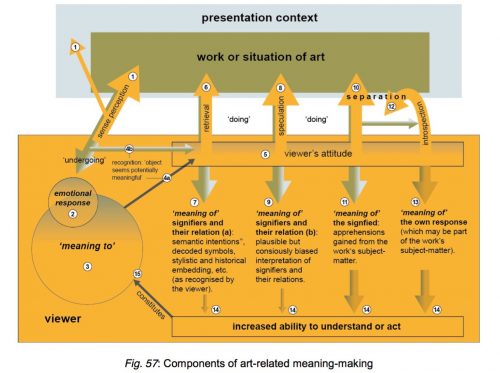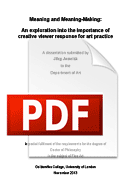PhD-Projekt
(Goldsmiths College, London, 2014)
Meaning and Meaning-Making:
An exploration into the importance of
creative
viewer response for art practice
Empirical research suggests that gallery and museum audiences have a strong propensity to make sense of artworks by understanding what the artist ‘means to say’, or what the ‘encoded message’ of a work might be. Conversely, many contemporary artists subscribe to the idea that observers may (or even should) endow their work with their own meaning. In response to this situation, this thesis asks: How can one facilitate a more individual engagement by viewers in the meaning making process?
To approach this task, the concepts of meaning and meaning-making are re-assessed and new definitions suggested that endeavour to relate these terms to discussions of art appreciation and art production. A great deal of attention has been given to processes of meaning-making as a collective, social process. In this work the main emphasis will be placed upon the individual viewer’s encounter of a work of art. To develop the concept of meaning-making, arguments from post-structuralist discourses, literature theory,
pragmatist aesthetics, and the psychology of art apprehension are considered. The relation between meaning, verbalisation, and affection, as well as between the viewer’s constructive activity and the artist’s intentions are discussed. This work also considers how the construction of meaning is influenced by contextual elements such as biological and social factors, the latter including the influence of the gallery environment. Existing theories, viewer testimonials, artists’ statements, and both contemporary and art historical examples are examined in order to determine various approaches that facilitate meaning-making processes.
This interdisciplinary approach brings together diverse and otherwise divided perspectives on the concept of meaning making and the meaning-making process. The ptoject is ultimately aimed at developing a better understanding of the artist-audience relationship. It is anticipated this will proffer a resource for art educators and for other visual artists.


